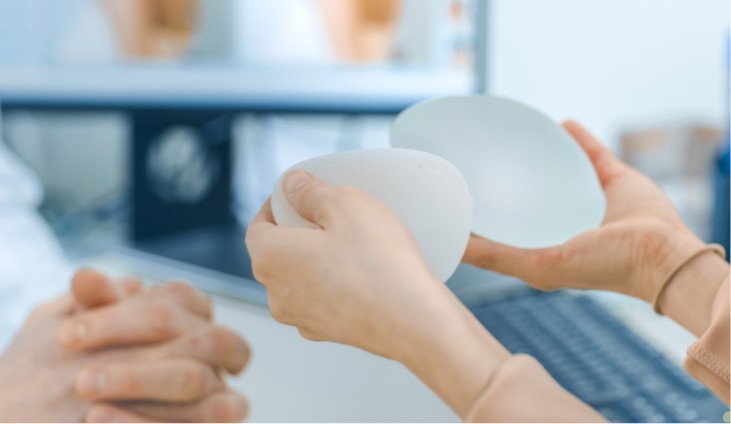- Category: Breast Implant Safety Matters
- Published:
BIA-ALCL: Covering the basics
If you’ve been doing your research on breast augmentation before going through the procedure, you’ve probably encountered the BIA-ALCL acronym. Let us break it down for you:
What is BIA-ALCL?
BIA-ALCL is a rare type of cancer known as non-Hodgkin’s lymphoma. The first case of ALCL was reported in 1997; however, in 2008, Dutch researchers conducted a case-control study of a group of women with a rare Lymphoma and found a higher association of ALCL with women who had breast implants than those women who had not. Three years later, the FDA (US Food and Drug Administration) launched an investigation into the possible association of ALCL with breast implants, which resulted in the World Health Organization (WHO) defining a specific type of ALCL as Breast Implant associated large anaplastic Cell Lymphoma (BIA-ALCL). Although BIA-ALCL is associated with breast implants, it is important to note that this is not breast cancer but a cancer of the immune system.
What are the symptoms of BIA-ALCL?
The most common symptoms of BIA-ALCL are usually persistent swelling and or pain around the breast, caused by a breast seroma (fluid build-up around the breast implant). This swelling can occur within a few days. Rarely, patients have also reported a lump under the skin in the breast or armpit, or capsular contracture (thick and noticeable scar capsule around the implant. Less common symptoms seen can include enlarged lymph nodes, persistent fever, and weight loss. The onset of symptoms can develop years after surgery (on average, 7-10 years); however, in some cases, BIA-ALCL has been known to develop as early as less than a year and as late as twenty-eight years after implant.
What is the risk of developing BIA-ALCL?
Although an individual’s risk of developing BIA-ALCL is rare, it is important to remember that cancer is a severe and life-threatening disease, particularly if not treated promptly. In most cases, BIA-ALCL is found in the scar tissue or fluid around the implant, but in some cases, it can spread throughout the body; therefore, early detection is fundamental. In most patients, BIA-ALCL is treated successfully with surgery, removing the implant and surrounding scar tissue. However, some patients may require chemotherapy and radiation therapy.
How is BIA-ALCL diagnosed?
Upon clinical presentation of suspected BIA-ALCL symptoms, your doctor will undertake an external evaluation of the breast using an ultrasound/ MRI or PET scan. In the case in which there is a mass or an extensive collection of fluid around the implant, a sample of cells from the fluid or tissue will be collected and sent to the lab for testing. The sample will be tested for two types of proteins; CD30+ (usually found in abnormally high amounts on lymphoma cells) and anaplastic lymphoma kinase ALK (helps cell growth). If the samples test negative, you will be directed to a plastic surgeon to discuss options for the treatment of the benign (non-cancerous) lumps and or excess fluid build-up. If clinical analysis tests positive, your doctor may undertake several further tests to understand cancer and how far it may have spread. This is known as “workup and staging” and involves several blood tests and additional imaging undertaken by a PET scan to gain a clearer picture of the treatment required.
How is BIA-ALCL treated?
BIA-ALCL is highly treatable and, in most cases, surgery is enough to treat and remove BIA-ALCL. However, depending on the stage of the BIA-ALCL, you may also require chemotherapy and/or radiation therapy. BIA-ALCL is usually localized in the seroma or contained within the capsule around the breast implant. Therefore, the surgery consists of complete removal of both the breast implant and the surrounding capsule, often referred to as a complete en-bloc capsulectomy. It is also highly recommended to remove the contralateral breast implant despite the non-presence of BIA-ALCL in the opposite breast. In rare cases in which cancer has spread to the lymph nodes, in addition to a capsulectomy, your surgeon may opt to undertake a lymph node dissection to remove suspicious lymph nodes.
What causes BIA-ALCL?
There is currently no concrete evidence as to what causes BIA-ALCL, and research is ongoing. However, currently, there seems to be a link between women who have (or had) textured breast implants and tissue expanders. Textured implants were designed in the late ’80s to reduce malposition and capsular contracture. Literature has suggested the triggers from these textured devices could be a result of particles from the device, tissue ingrowth into the large surface area of the macrotextured devices, and or chronic abrasion to the breast pocket from the sandpaper-like surface from the textured devices. Interestingly, there have been no cases seen in patients with smooth devices only.
I have slight pain and swelling in my breast, could this be BIA-ALCL?
If you have breast implants and experience any problems with your breasts, should that be a pain, swelling, lumps in or around the breasts or armpits, or a change in shape, it is always recommended to seek medical advice, particularly if the symptoms have developed quite sometime after your surgery. The symptoms may not be a case of BIA-ALCL; it could indicate another complication.
What if I have breast implants but no symptoms?
It is important to remember, regardless of whether you have breast implants or not, to always promote your breast health. Although separate entities, both breast cancer and BIA-ALCL, can be detected by observing breast changes and regular self-breast examination. This includes checking areas around the breast, including the armpit and up to the collarbone for any abnormal changes or lumps. It is normal for breasts to change throughout the month, and in some cases, breasts can be naturally “lumpy”; therefore, getting to know the look and feel of your breasts and what is normal for you can help detect early changes that could indicate cancer.
I am scared of getting BIA-ALCL; how can you check that I have not got BIA-ALCL?
It is recommended to always look after your breast health, regardless of whether you have breast implants or not. Although BIA-ALCL is rare, breast cancer is not, affecting one in nine women. Therefore, the advice is always to commit to regular self-breast examinations and yearly check-ups with your doctor. If you do have breast implants and have had your breast implants for several years, it is important to remember that breast implants are not lifetime devices, and you may find there is a safer, more advanced option available to you.
Can the symptoms of BIA-ALCL occur in one or both breasts?
Interestingly, it is more common to experience the disease in one breast alone; however, although rare, it is possible to find the presence of BIA-ALCL in both breasts. These symptoms may occur well after the surgical incision has healed, often 7-10 years after implant placement.
How can I check if the implants I have are at risk of BIA-ALCL?
The first step is to identify the type of implants you have. BIA-ALCL appears to be related to certain textured surfaces in both gel and saline implants. At the time of your surgery, you may have received an implant ID card; this holds the information you require, such as the date of surgery, implant size, and implant type. The latest generation of breast implants has a transponder enabling the unique ID information to be required instantly through telemetry. If you no longer have your ID card or have a previous generation implant, your surgeon who performed the surgery or the hospital/ clinic where your surgery took place should be able to acquire the information through your medical records. If your surgery took place some time ago, and your surgeon is no longer in practice. Your breast implant manufacturer may be able to help you locate this information through their tracking systems.
Should I get my breast implants removed?
Due to the low incidence of BIA-ALCL (even with the aforementioned textured implants), oncologists and surgeons do not recommend removing these implants when you are asymptomatic (lack of BIA-ALCL symptoms). The risk of having additional surgery is higher than developing BIA-ALCL. If you had successful breast implant placement years ago and cancer-like symptoms are only emerging, it is important to see a doctor immediately. Hopefully, any discomfort or swelling you are experiencing is not the result of breast implant associated cancer, but there is always strength and peace of mind in knowing for sure. Moreover, if you have had your breast implants for quite some time and are happy about your surgery but concerned about your implants’ age, it might still be worth seeing a medical professional about implant exchange to an innovative version to help bring you peace of mind.
I have textured implants, should I replace with a different type of implant?
Scientists are still determining the exact connection between textured breast implants and BIA-ALCL. Many researchers believe the development of ALCL in the breast implant is due in part to the reaction between the implant and the body.
Textured implants were created to get the implants to stick to the tissue inside the body. The purpose of delivering two benefits was previously a disadvantage of the older smooth generation implant created in the 60s. The benefits were minimizing the risk of capsular contracture (tightening of the scar tissue around the breast implant) and movement inside the pocket. However, the benefits did not majorly reduce the risks and led to additional issues. With that said, the technology of these rough devices, in addition to the first edition of smooth devices, are concepts that are over 30 years old.
Today, women have the option of next-generation implants that fit the need of the modern world and enhanced surgical techniques that can help overcome previous issues. Replacing your implants, like any surgical procedure, can also be a risk, so long as you show no signs or symptoms; as mentioned before, many healthcare professionals recommend leaving them in. Should you consider or feel more comfortable with a new set of implants, then you should contact your plastic surgeon; he can inform you about the latest technologies and developments in breast implant ergonomics.
I have smooth implants; can they develop BIA-ALCL?
To date, there have been no cases of BIA-ALCL with smooth implants alone. The cases of BIA-ALCL, which have been reported so far, have all included previous surgeries with a textured breast implant or tissue expander.
I have saline breast implants; can they develop BIA-ALCL?
Currently, there is no evidence linking the type of implant filling to the causes of BIA-ALCL, which appears to be isolated to the shell surface alone. Although the implant fill does not appear to be a risk, a large study has not been conducted to say for definite. Both saline and gel implants with textured shell surfaces have been associated with BIA-ALCL.
My implants have been recalled, should I have them removed even if I do not have symptoms?
Replacing your implants, like any surgical procedure, is also a risk, so long as you show no signs or symptoms, as mentioned before, the recommendation is to leave them in. Should you consider or feel more comfortable with a new set of implants, then you should contact your plastic surgeon; he can inform you about the latest technologies and developments in breast implant ergonomics.
How long do breast implants last?
Breast implants are not lifetime devices. Many factors affect the lifetime of breast implants, which largely depends on the type of breast implant, the length of time the breast implant has been inside the body, and the surgical technique.
Moreover, as with all advancements in technologies, breast implant designs and safety develop over time. Therefore, if you have had your breast implants for several years or you would like to refresh the aesthetic result of your breast augmentation, additional surgery may well be the option for you.
What should I expect after my BIA-ALCL surgery?
Following your surgery, your doctor will continue to monitor you through regular check-ups in 3-6 month increments for around two years. Some of these routine check-ups may also include PET or CAT scans.
Do I need Radiation or Chemotherapy after being diagnosed with BIA-ALCL?
Although in the majority of cases surgical intervention is enough to treat BIA-ALCL, if the cancer is in an advanced stage or has spread beyond the capsule, you may need radiation or chemotherapy in addition to surgical intervention.
What does radiation therapy involve?
Radiation therapy is a procedure that uses high-energy X-rays (photons) to kill cancer cells that may remain after surgery. Although it depends on individual cases, typical BIA-ALCL treatment involves several small doses of radiation a week for up to 4-6 weeks.
What does chemotherapy involve?
Chemotherapy utilizes drugs to shrink and control the growth of tumors or to relieve cancer symptoms. The type of medication you require depends on the stage of BIA-ALCL and can be administered orally or by injection. Some Chemotherapy drugs can have side effects, although the severity differs patient to patient but can include hair loss, fatigue, and nausea.
If I replace my breast implants with other implants, am I still at risk of developing BIA-ALCL?
If you opt to remove or replace your breast implants, there is still a risk of developing BIA-ALCL. There have been cases in which women have developed BIA-ALCL from a history of retained scar tissue of previous textured implants.
I had breast implant reconstruction after my cancer, am I at risk of BIA-ALCL?
It appears that there is a link between BIA-ALCL and textured devices; therefore, if you received textured breast implants or tissue expanders at the time of your reconstruction surgery, there is still a risk of BIA-ALCL.
I was diagnosed with BIA-ALCL and have had my implants removed; what are the alternative options to enhance the appearance of my breasts?
There are a couple of options for you to restore the appearance of your breast; one option is a second implant surgery with a new generation implant without a textured surface, or you can opt to reconstruct your breast using autologous tissues ( the body’s own tissues), or fat transfer from another area of the body. There is also the option of combining these procedures to reconstruct the breast.
Am I covered by my insurance for implant removal if I am diagnosed with BIA-ALCL?
In most cases, health insurance companies cover for treatment under the circumstances of BIA-ALCL.
We hope that this information was helpful on your journey about learning more about the pros and cons of breast augmentation.
* The content provided herein is for informational and educational purposes only and is not intended as medical advice or as substitute for a consultation with a physician.
Sources
American Society of Plastic Surgeons (2020) Breast Implant Associated Anaplastic Large Cell Lymphoma (BIA-ALCL)s [online] available at:- https://www.plasticsurgery.org/patient-safety/breast-implant-safety/bia-alcl-summary. Accessed August 2020.
Bautista-Quach MA Nademanee A, Weisenburger DD, Chen W, Kim YS (2013) Implant-Associated Primary Anaplastic Large-Cell Lymphoma With Simultaneous Involvement of Bilateral Breast Capsules, Clinical Breast Cancer Journal, Vol. 13(6) – pp. 492-495.
Breast Cancer Org (2020) What Is BIA-ALCL? [online] available at: https://www.breastcancer.org/treatment/surgery/reconstruction/types/implants/special-report/anaplastic-large-cell-lymphoma. Accessed August 2020.
Cancer Research UK (2017) Treatment options for breast cancer | Cancer Research UK [online] Available at: https://www.cancerresearchuk.org/about-cancer/breast-cancer/treatment/treatment-decisions. Accessed August 2020.
Clemens MW Decoster RC, Fairchild B, Bessonov AA, Santanelli Di Pompeo F (2019) Finding Consensus after Two Decades of Breast Implant-Associated Anaplastic Large Cell Lymphoma , Semin Plast Surg, Vol. 33 (4). – pp. 270-278..
DePaola N., & Coggins, H(2019) Breast Implant-Associated Anaplastic Large Cell Lymphoma: What We Know ,Journal of the advanced practitioner in oncology, Vol. 10 (1) – pp. 54-61.
Food and Drug Administration (2020) Breast Implants: Update-Breast Implant Associated Anaplastic Large Cell Lymphoma (BIA-ALCL) [Online] available at: https://www.fda.gov/medicaldevices/productsandmedicalprocedures/implantsandprosthetics/breastimplants/ucm239995.htm. Accessed 20 August 2020.
Groth A.K , Graf, R (2019) Breast Implant-Associated Anaplastic Large Cell Lymphoma (BIA-ALCL) and the Textured Breast Implant Crisis, Aesth Plast Surg. – Vol. 44. – pp. 1-12.
Groth A.K. and Graf, R(2020) Correction to: Breast Implant-Associated Anaplastic Large Cell Lymphoma (BIA-ALCL) and the Textured Breast Implant Crisis. Aesthetic Plastic Surgery, Aesthetic Plast Surg. Vol. 44. (5) pp. 1-12.








